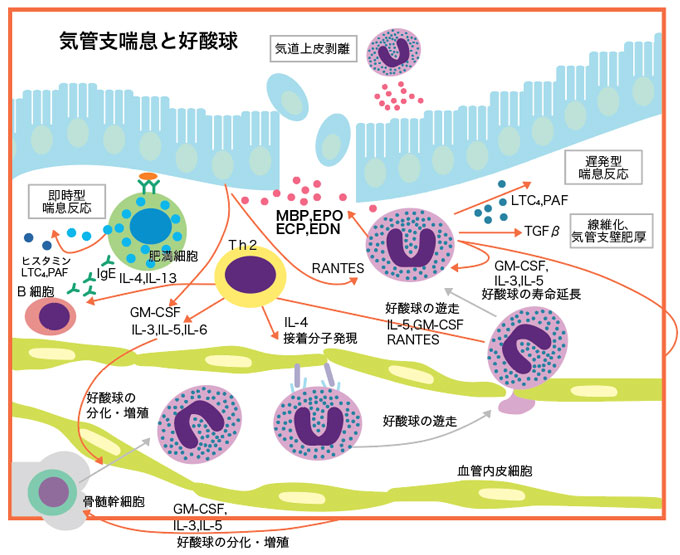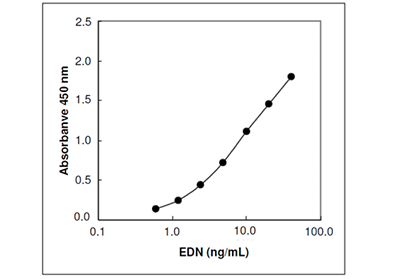EDN ELISA Kit
EDNとは

好酸球は活性化に伴って主要塩基性タンパク(Major Basic Protein :MBP)、好酸球塩基性タンパク(Eosinophil Cationic Protein: ECP)、好酸球ペルオキシダーゼ(Eosinophil Peroxidase: EPO)および好酸球由来ニューロトキシン(Eosinophil Derived Neurotoxin: EDN)などの様々な陽イオンタンパク質を放出します。EDNはEosinophil Protein X(EPX)とも呼ばれ、分子量18-21 kDaの単鎖糖たんぱく質で、ECPと共にリボヌクレアーゼスーパーファミリーに属します。EDNはECPと高い相同性を示しますが、リボヌクレアーゼ活性はECPより100倍高く、生化学的に神経毒性を示しますが細胞毒性は示しません。
EDNは炎症性腸疾患(IBD)や食物アレルギー、逆流性食道炎、腸管寄生虫による炎症検出などに用いられています。
本キットを用いた論文で、ALS(筋萎縮性側索硬化症)患者の血清中EDN濃度は健常人やアルツハイマー患者、パーキンソン病患者よりも高く、ALSの診断マーカーになる可能性が報告されています。
好酸球の遊走と活性化はアレルギー疾患における組織障害に重要な役割を果たしていることが示唆されています。EDNは好酸球の活性化および脱顆粒の指標になると考えられています。EDN ELISA KitはELISA法によって特異的かつ高感度にヒトEDNを測定する試薬です。
測定原理
EDN ELISA Kitは、サンドイッチELISA法によってヒトEDNを測定するキットです。本キットの検出感度は0.62 ng/mLです。また、ECPとの交差反応は示しません。
抗 ヒトEDNモノクローナル抗体を感作したマイクロカップに、サンプルを添加し、抗原-抗体反応をさせます。洗浄後、ペルオキシダーゼ標識抗ヒトEDNポリクローナル抗体を添加して反応させ、抗原-抗体-標識抗体の複合物を形成させます。洗浄後、テトラメチルベンチジンと過酸化水素の溶解液を基質溶液として添加し、酵素(ペルオキシダーゼ)により発色させ、反応停止後、吸光度(A450)を測定してヒトEDNを検出します。

キット構成
| Name | Materials | Quantity (1 kit) |
|---|---|---|
| Microwells | microwell strips coated with anti-human EDN antibody | 8-well strip × 12 strips |
| EDN standard | The standards of 7 types of concentrations (ready-for-use) |
1 mL × 7 vials |
| Assay diluent | Buffer for diluting samples (ready-for-use) |
50 mL × 1 bottle |
| Conjugate | Peroxidase conjugated anti-human EDN antibody (ready-for-use) |
12 mL × 1 bottle |
| Wash concentrate | Buffer for washing microwells (×10) | 100 mL × 1 bottle |
| Substrate | TMB/H2O2 solution (ready-for-use) | 20 mL × 1 bottle |
| Stop solution | 0.5 M H2SO4(ready-for-use)(irritant) | 20 mL × 1 bottle |
| Positive control | - | 0.2 mL × 1 vial |
| Negative control | - | 0.2 mL × 1 vial |
標準曲線の例

再現性
1.同時再現性試験
血清3例を用いて、同時に9回測定したところ、下表の結果が得られました。
| Sample | serum 1 | serum 2 | serum 3 |
|---|---|---|---|
| Number of determinations | 9 | 9 | 9 |
| Mean(ng/mL) | 1.9 | 3.5 | 16.0 |
| C.V.(%) | 3.6 | 2.8 | 2.6 |
2.日差再現性試験
血清3例を用いて、測定日を変えて4回測定したところ、下表の結果が得られました。
| Sample | serum 1 | serum 2 | serum 3 |
|---|---|---|---|
| Number of determinations | 4 | 4 | 4 |
| Mean(ng/mL) | 3.8 | 4.2 | 10.3 |
| C.V.(%) | 6.5 | 7.2 | 9.4 |
文献リスト
- Nagase H et al. Expression of CXCR4 in eosinophils: functional analyses and cytokine-mediated regulation. J Immunol. 164, 5935-43 (2000)(PMID:10820276)
- Thomas LL et al. Immobilized lactoferrin is a stimulus for eosinophil actovation. J Immunol. 169, 993-9 (2002) (PMID:12097406)
- Decot V et al. Heterogeneity of expression of IgA receptors by human, mouse, andrat eosinophils. J Immunol. 174, 628-35 (2005) (PMID:15634880)
- Morokata T et al. A novel, selective, and orally available antagonist for CC chemokine receptor 3. J Pharmacol Exp Ther. 317, 244-50 (2006) (PMID:16339911)
- Munitz A et al. CD48 is an allergen and IL-3-induced activation molecule on eosinophils. J Immunol. 177, 77-83 (2006) (PMID:16785501)
- Mathur SK et al. Age-related changes in eosinophil function in human subjects. Chest 133, 412-9 (2008) (PMID:18252914)
- Gaudreault E and Gosselin J. Leukotriene B4 induces release of antimicrobial peptides in lungs of virally infected mice. J Immunol. 180, 6211-21 (2008) (PMID:18424743 )
- Mansson A and Cardell LO. Role of atopic status in Toll-like receptor (TLR)7- and TLR9-mediated activation of human eosinophils. J Leukoc Biol. 85, 719-27 (2009) (PMID:19129482)
- Liu GT et al. Eosinophil-derived neurotoxin is elevated in patients with amyotrophic lateral sclerosis. Mediators Inflamm. 2013, 421389 (2013) (PMID:23533305)



